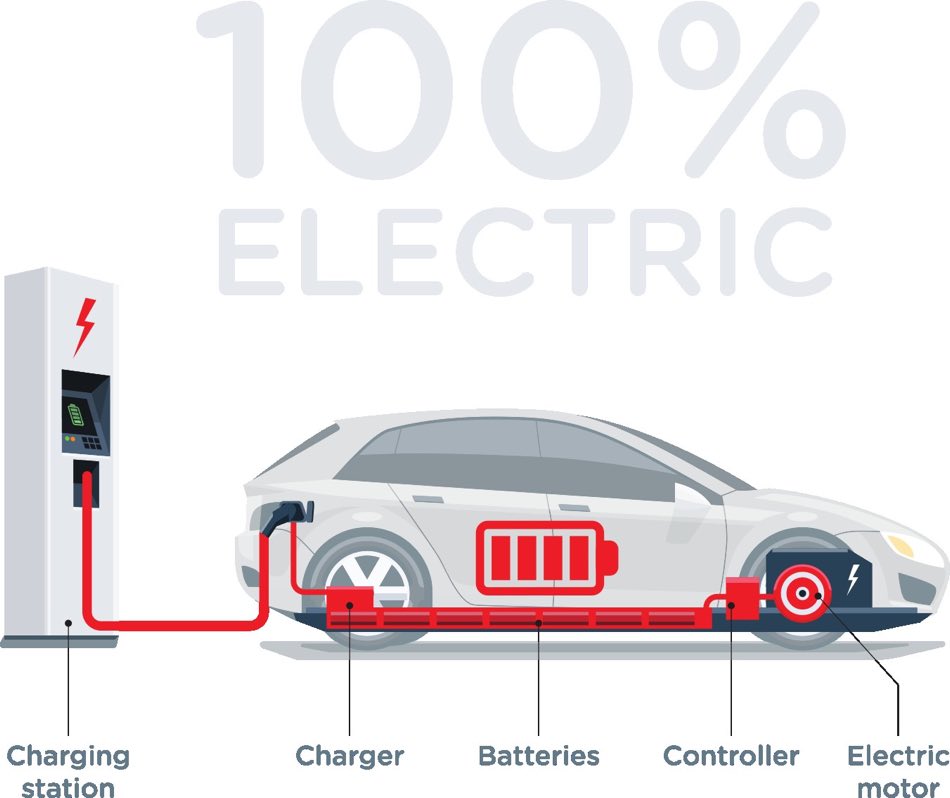Unlike internal combustion vehicles that use gasoline or diesel engines, electric cars, and trucks rely on electric motors powered by batteries or fuel cells. According to Bloomberg, EVs are anticipated to account for 40% of all vehicle sales by 2030, with major car manufacturers such as General Motors committing to a complete transition to electric vehicles by 2035. This shift towards electric vehicles is driven by the significant benefits of EVs, including reduced maintenance costs, better driving experience, and lower carbon emissions. If you want to learn more about electric vehicles work, read for further information.
Different Types of Electric Vehicles
There are four distinct categories of electric vehicles currently available for purchase.
Plug-in hybrid electric vehicles, or PHEVs, have both a gasoline and an electric motor with a rechargeable battery. These vehicles can be plugged in and recharged from an electrical outlet or EV charger, which allows them to drive longer distances using only electricity. Once the battery is depleted, the gasoline engine powers the vehicle.
Hybrid vehicles combine a traditional engine with an electric motor to achieve improved fuel efficiency compared to gasoline-powered cars. In addition, hybrids emit less carbon and have lower fuel costs than gasoline-powered vehicles.
Fuel cell vehicles rely on hydrogen gas to operate an electric motor instead of using gasoline, like traditional vehicles. Fuel cell cars use a combination of hydrogen and oxygen to produce electricity that powers the motor, making them a type of electric vehicle. Unlike other EVs, fuel cell cars have a similar range and refueling process to traditional vehicles. However, they make up a small portion of the market and have limited refueling infrastructure.
Battery Electric Vehicles (BEVs) run on an electric motor powered by electricity stored in a battery pack. You can recharge BEV batteries by using electricity from a wall socket or an EV charger. While electric vehicles don’t produce emissions directly, the electricity that powers them may still create some pollution. To learn more about electric vehicle emissions read our article, “Electric Car Emissions Versus Gas Vehicles“.
Battery Electric Vehicle Key Components
Battery electric vehicles are considered the future among the four types of electric vehicles. PHEVs and hybrids are transitional options that will eventually be phased out as internal combustion engines become less prevalent. Fuel cell vehicles are not viable due to lack of support, infrastructure, and availability. Here is a breakdown of their key components to better understand how electric vehicles work.
Auxiliary Battery: The purpose of the auxiliary battery in an electric vehicle is to provide power to the vehicle’s accessories. This battery is similar to the ones found in gasoline-powered vehicles.
Charging Port: The charging port connects the vehicle to an external electric outlet or EV charger, which helps charge the battery pack.
DC/DC Converter: This device transforms the high-voltage DC power from the battery pack into the low-voltage DC power required to operate vehicle accessories and recharge the auxiliary battery.
Electric motor: The electric motor of an electric vehicle uses power from the battery pack to operate the wheels. In addition, some motors are capable of regeneration, which allows them to capture and reuse power for longer periods.
Onboard charger: The device takes the AC electricity from the charging port and converts it to DC power to charge the battery. It also communicates with the charging equipment and keeps track of the battery’s voltage, current, temperature, and charge level during the charging process.
Power electronics controller: The power electronic controller is responsible for regulating the flow of electrical energy from the battery. It controls both the speed of the electric motor and the torque it produces.
Thermal System: This system ensures that the engine, electric motor, power electronics, and other components maintain an appropriate operating temperature range..
Battery Pack: The battery pack stores electricity that the electric motor can use.
Transmission: The transmission transfers power from the electric motor to the wheels to create propulsion.
How Electric Vehicles Charge
Electric vehicle charging differs from gas vehicles, requiring frequent trips to gas stations. If you have a home EV charger, your electric vehicle can typically charge overnight and start the following day with a full battery, except for long road trips that exceed the vehicle’s battery driving range. There are two methods of charging: DC Fast charging, which can recharge a battery in as little as 18 minutes. And the slower Level 2 charging, which can be installed in homes and found at destinations like malls, movie theaters, and hotels.
DC fast charging has three standards, and an electric vehicle will support one of the three standards. There are compatible DC fast chargers throughout the country for recharging needs. To learn more about EV charging, please refer to our article, “Understand Electric Car Charging.”
For more information on Electric Vehicles, please check out our website, Electric Driver. We offer guidance on purchasing, as well as details on incentives, all focused on electric vehicles.
